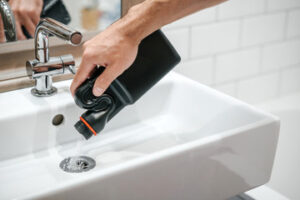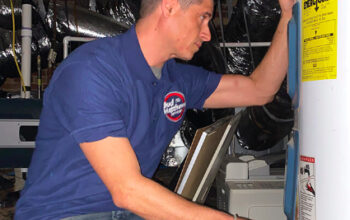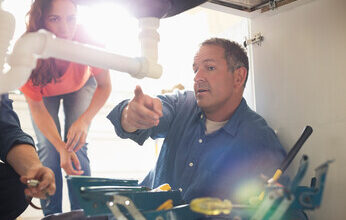Philadelphia Drain Cleaners come in liquid, gel, foam, and crystal forms. They are heavier than water, sinking in to reach the clog and causing a chemical reaction.
They are typically effective at dissolving hair and grease but can damage pipes if used frequently or too vigorously. They also generate toxic fumes and can harm health if they come into contact with skin or eyes.

Chemical drain cleaners are liquid, gel, or powder products that dissolve hair, food, grease, and other organic materials that block a pipe. They’re available at hardware stores and most major retailers, and they’re often advertised as easy to use and offering immediate results.
While they can be effective in an emergency, chemical drain cleaners have many downsides that make them less than ideal. They’re typically very acidic, and they release corrosive chemicals into the air that can damage pipes and water fixtures. Most importantly, chemical drain cleaners can be dangerous to your health if you’re not careful when handling them. They often produce fumes that are irritating to your lungs and eyes, and prolonged exposure can cause chemical burns.
The primary ingredient in most commercial chemical drain cleaners is sodium hydroxide, also known as lye. Sodium hydroxide is extremely caustic and can burn skin and harm the respiratory tract if it comes into contact with your skin or mucous membranes. It’s important to wear rubber gloves and a face mask when using chemical drain cleaners, and to read and follow the manufacturer’s instructions carefully.
Most chemical drain cleaners work through chemical reactions that donate or receive electrons, breaking down and dissolving the material clogging the pipe. They all generate heat as a byproduct of these chemical reactions, and they can melt or warp some types of plumbing materials. In addition, they can erode metal pipes over time if they come into contact with them.
If you’re considering using chemical drain cleaners, it’s important to know that they can be damaging to your pipes, especially if they’re used on older pipes. The acids and other harsh ingredients in these cleaners can eat through the protective zinc layer of galvanized steel pipes, exposing the base metal to corrosion. This can lead to leaks, rust and burst pipes.
Caustic chemical drain cleaners, such as lye and caustic potash, are bases that give off electrons to the clogging material, creating a reaction that releases heat and breaks down the substance. Oxidizing chemical drain cleaners, such as household bleach, peroxides and nitrates, work similarly by releasing heat to break down organic materials in the pipe. While these cleaners are relatively safe for most modern pipes, they can erode or damage older pipes made of copper, cast iron or galvanized steel.
When your drains become fully or partially clogged, it can be tempting to reach for chemical cleaners. These products can be fast and effective, but they can also damage your pipes and leave behind dangerous fumes. Instead, try using a safer solution: enzyme-based drain cleaners.
Enzyme drain cleaners contain bacteria and natural enzymes that break down organic material in your plumbing system. This includes hair, soap scum, food waste, and toilet paper. The result is a cleaner drain that is safe for your pipes and the environment. These cleaners are available in liquid and powder form. A liquid enzyme drain cleaner can be poured directly down your drain, while a powder-based drain cleaner needs to be mixed with water before being poured down the drain.
These organic drain cleaners are ideal for preventative maintenance, as they work slowly to digest gunk that can lead to clogged drains and sewer lines. They are also safer for the environment than chemical cleaners. However, they don’t work as well on blockages that are formed from metal or plastic materials.
If you’re looking for an easy way to keep your drains running smoothly, consider using a pre-measured enzymatic drain cleaner pod. These convenient, septic-safe solutions dissolve toilet paper and other organic waste materials that can cause drain clogs and unpleasant odors. Just drop one of these pre-measured drain cleaner pods down your drain every month to help keep your home’s plumbing in tip-top shape.
Another option is to use a liquid-based, biological drain cleaner. These products contain a mixture of bacteria and natural enzymes that liquefy fats, oils, and grease (FOG) in your drain line and eliminate clogs and odors. However, these biological cleaners don’t work as quickly as chemical cleaners and may take up to several hours to clear even a small FOG clog.
While enzymatic and biological drain cleaners are safer for your pipes than chemical cleaners, they’re not as effective against larger clogs or blockages. If you have a stubborn clog that’s formed from metal or plastic, it’s best to call in a professional plumber to avoid damaging your pipes and to avoid dangerous fumes.
A plunger is a reliable and inexpensive option for clearing a drain or toilet. It works by creating a seal over the drain opening when it’s pressed down over the clogged pipe. This forces air to flow through the pipe and break up or dislodge clogs. A good quality plunger is designed to withstand vigorous use and can last for years.
There are many different types of plungers on the market, and it’s important to choose one that is suited for your home. Some models have suction cups that attach to the bottom of a drain, which helps create a strong seal and increase efficiency. Other models are designed with a flat surface that fits the shape of a sink or toilet bowl to eliminate air bubbles and maximize pressure. You can also find special designs, such as the Eterna Air Drain Blaster, that shoots a stream of compressed air into the clogged pipe to break up or dislodge blockages.
Liquid, gel, foam, crystal, and powder drain cleaners usually contain a basic or acidic cleaning agent. Some are very caustic and can irritate your skin, eyes, and nose. They also can damage pipes if they come into contact with them. Some chemical cleaners may even be dangerous to the environment, if they seep into groundwater or soil.
Oxidizing drain cleaners are one of the most popular types of liquid cleaners. They contain ingredients like sodium hydroxide (lye), which reacts with water to produce heat and dissolve clogs. They can be effective on a variety of materials, but they are especially useful for organic clogs such as hair or grease.
Acidic drain cleaners are the harshest chemicals used in drain cleaners. They often have high concentrations of sulfuric acid, which can corrode metal pipes. These products are typically only recommended for professional plumbers who have the proper training and equipment to safely use them.
Although chemical drain cleaners can be an effective solution for a temporary clog, it’s always best to try other methods before using them again. Long-term exposure to chemical drain cleaners can be damaging to your lungs and respiratory tract, and they’re not environmentally friendly either. For a safer and more natural alternative, try mixing baking soda and vinegar or running hot water down your drains regularly.
There are many options for a natural drain cleaner that will be safe for your pipes. Some of them are made from household items, while others are commercially available. Some of these products use a similar process as chemical drain cleaners, but without the toxic chemicals.
Baking soda and vinegar is one of the most popular alternatives to chemical drain cleaners. This combination creates a chemical reaction that lifts grime and debris from your pipes. Simply pour a cup of baking soda down your drain and then follow it with a cup of boiling vinegar. This will create a fizzy, bubbling chemical reaction that can dislodge even the most stubborn clogs. For best results, repeat this process as needed until your clog is gone.
Another option is a biological enzyme drain cleaner. These products contain bacterial cultures that break down organic materials such as hair, soap scum, and food waste. Many of these products are also safe for septic systems and pipes. However, they may not be as effective on serious clogs as a plunger or drain snake.
Natural, eco-friendly chemical drain cleaners are becoming more common as people become aware of the negative effects of traditional chemical cleaners. These alternative cleaners are safe for your pipes, don’t produce toxic fumes, and are easy to make at home.
For example, a name-brand bottle of cola can dissolve a clog and deodorize your drain in just a few hours. All you need to do is pour the soda down your drain and wait a few hours before running hot water. This cleaner is ideal for small clogs, such as those caused by hair or soap scum.
Other natural drain cleaners include homemade recipes, such as 1/2 cup of baking soda with 1/4 cup of salt and 1 cup of vinegar. This mixture will clear your drain of grease and sludge, and is safe for most pipe types. It’s also inexpensive and environmentally friendly.
A final option is an oxidizing drain cleaner. These products work by stripping electrons from the clog’s material, which makes it easier for your pipes to remove it. They’re usually a bit more expensive than other drain cleaners, but they’re safe for most pipe types and are effective on most clogs.


